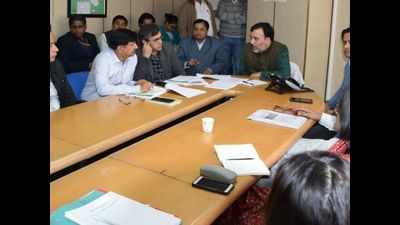- News
- City News
- delhi News
- In a month, Delhi to get pollution data even as you speak
Trending
This story is from February 21, 2020
In a month, Delhi to get pollution data even as you speak
In a month, Delhi will start getting detailed reports on the composition and contribution of different sources of air pollution, Delhi’s environment minister Gopal Rai said on Thursday.

Delhi environment minister Gopal Rai held an important meeting with officials related to the evironment department. (Image tweeted by@AAPDelhi)
NEW DELHI: In a month, Delhi will start getting detailed reports on the composition and contribution of different sources of air pollution, Delhi’s environment minister Gopal Rai said on Thursday.
The real-time source apportionment set-up, which has been installed by Delhi government in association with Washington University, is likely to be functional soon, and its first report will be presented by March, Rai said.
Track the pollution level in your city

Meanwhile, DPCC officials said the project would be able to provide an accurate data on the contribution of each sector in both summer and winter, allowing them to act on the sources of pollution. “The real-time data is important to see the improvement in each sector. If the contribution from the transport sector will be high, we can aim at reducing congestion on roads. If it is from industries, our teams can specifically target them and check for clean fuel usage,” said a DPCC official.
While the first report will be made available in March, DPCC officials said a decision was yet to be taken on how often the subsequent reports would be released. “We have organised several meetings over the past few months. After the final calibration, data will be available from April. It will also be provided to our teams for further action,” added the official.
The real-time source apportionment will be done using analysers installed at one location initially. Particulate matter will be taken into consideration from 26 air quality monitoring stations. Real-time monitoring and sampling of PM1, 2.5 and 10 will be carried out in addition to the various aerosols and compounds, the official said. As part of the study, an algorithm is also being developed to help DPCC analyse long-term data, he added.
In January 2019, the government had signed an MoU with the Washington University to determine real-time sources of pollution through the year. A long-term source apportionment study, however, may take 1-2 years to complete.
The real-time source apportionment set-up, which has been installed by Delhi government in association with Washington University, is likely to be functional soon, and its first report will be presented by March, Rai said.
Track the pollution level in your city

The newly-appointed minister said he would be visiting the headquarters of Washington University in Delhi near Major Dhyanchand stadium on Friday to meet the scientists and understand how the data could be utilised. “We had a number of studies on source-apportionment carried out in the past, but these are old studies now. A lot has changed in Delhi since. Not only do we need to know the highest source of pollution, but also how this changes every few months,” said Rai.
Meanwhile, DPCC officials said the project would be able to provide an accurate data on the contribution of each sector in both summer and winter, allowing them to act on the sources of pollution. “The real-time data is important to see the improvement in each sector. If the contribution from the transport sector will be high, we can aim at reducing congestion on roads. If it is from industries, our teams can specifically target them and check for clean fuel usage,” said a DPCC official.
While the first report will be made available in March, DPCC officials said a decision was yet to be taken on how often the subsequent reports would be released. “We have organised several meetings over the past few months. After the final calibration, data will be available from April. It will also be provided to our teams for further action,” added the official.
The real-time source apportionment will be done using analysers installed at one location initially. Particulate matter will be taken into consideration from 26 air quality monitoring stations. Real-time monitoring and sampling of PM1, 2.5 and 10 will be carried out in addition to the various aerosols and compounds, the official said. As part of the study, an algorithm is also being developed to help DPCC analyse long-term data, he added.
In January 2019, the government had signed an MoU with the Washington University to determine real-time sources of pollution through the year. A long-term source apportionment study, however, may take 1-2 years to complete.
End of Article
FOLLOW US ON SOCIAL MEDIA










